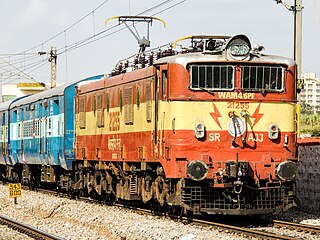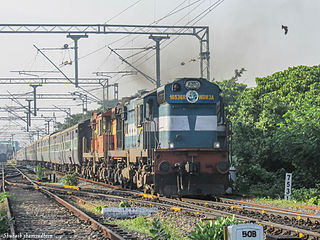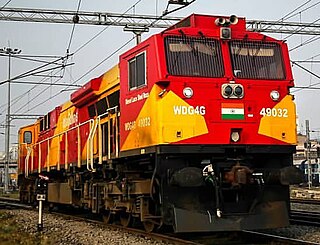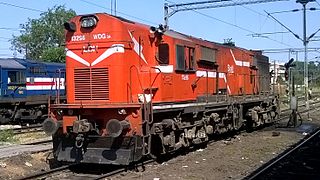Related Research Articles
Indian Railways operates India's railway system and comes under the purview of the Ministry of Railways of Government of India. As of 2023, it maintains over 108,706 km (67,547 mi) of tracks and operates over 13,000 trains daily with a fleet of 14,800 locomotives. The railways primarily operates a fleet of electric and diesel locomotives along with a few compressed natural gas (CNG) locomotives. Steam locomotives are operated on mountain railways and on heritage trains.

The Indian locomotive class WDM-2 is a class of diesel-electric locomotive that was developed in 1962 by American Locomotive Company (ALCO) for Indian Railways. The model name stands for broad gauge (W), Diesel (D), Mixed traffic (M) engine, 2nd generation (2). They entered service in 1962. A total of more than 2,700 WDM-2 was built at ALCO and Banaras Locomotive Works, Varanasi between 1962 and 1998, which made them the most numerous class of mainline diesel locomotive until its successor the WDM-3A.

The Indian locomotive class WAM-4 is a class of 25 kV AC electric locomotives that was developed in 1970 by Chittaranjan Locomotive Works for Indian Railways. The model name stands for broad gauge (W), alternating current (A), mixed traffic (M) locomotive, 4th generation (4). They entered service in March 1971. A total of 500 WAM-4 were built at CLW between 1970 and 1983, which made them the most numerous class of mainline electric locomotive till its successor the WAG-5.

The Indian locomotive class WDP-4 is a passenger-hauling diesel-electric locomotive with AC electric transmission designed by General Motors Electro-Motive Division and built by both GM-EMD and under license by Banaras Locomotive Works (BLW) of Varanasi, India for Indian Railways as the classes WDP4, WDP4B and WDP4D. The GT46PAC is a passenger version of the previous Indian Railways EMD GT46MAC freight locomotive. The locomotive has a 16-cylinder 710G3B diesel engine and is one of the fastest diesel-electric locomotives in service in Indian Railways.
The ALCO DL560C is a series of diesel-electric locomotive with AC electric transmission designed by the American Locomotive Company and produced under license by Banaras Locomotive Works (BLW) Varanasi, India for Indian Railways as their classes WDM-2, WDM-3A/2C, WDM-3D and WDG-3A for operation in India. The locomotive is fitted with a 16-cylinder ALCO 251 B, C diesel engine. In the early 1960s Indian Railways needed a reliable diesel workhorse to gradually replace its steam locomotive fleet. Equal numbers of ALCO's DL560C and EMD's G16 were chosen for trials. More locomotives of each of these were purchased for more trials. Indian Railways was keen on producing these locomotives in the country rather than depending on imports. EMD did not agree for a Transfer-of-Technology, while ALCO did. Thus ALCO DL560C was chosen for the job due to its easy maintenance, reliability and simple operation. And from then on vast numbers of this loco in different configurations have been produced and remain the main diesel traction power of Indian Railways.

The Indian locomotive class WDM-3A is a class of diesel–electric locomotive that was developed in 1993 by Banaras Locomotive Works (BLW), Varanasi for Indian Railways. The model name stands for broad gauge (W), Diesel (D), Mixed traffic (M) engine, with 3300 horsepower (3A). The WDM-3A is a later classification of earlier WDM-2C. They entered service in 1994. A total of 143+ were built at ALCO and Banaras Locomotive Works between 1994 and 2003 with rest of the 1246 units being rebuilt from WDM-2 which made them the most numerous class of mainline diesel locomotive until the WDG-4.

The YDM-4 is a class of diesel locomotives operating on Indian Railways. The first units were built by the American Locomotive Company (Alco) in 1961. Since 1968, members of the class have been manufactured in India by the Banaras Locomotive Works (BLW), Varanasi. The model name stands for metre gauge (Y), diesel (D), mixed traffic (M) engine. The YDM-4 has been the most successful metre gauge diesel locomotive in India. The YDM-4 locos have a maximum speed of 100 km/h (62 mph), restricted to 85 km/h (53 mph).

Diesel Loco Shed, Vatva is an engine shed located in Vatva, Gujarat in India. It is located north-east of Vatva falling under Ahmedabad railway division. The shed caters to the need of freight as well as passenger trains.

Diesel Loco Shed, Sabarmati is an locomotive maintenance shed located in Sabarmati, Ahmedabad, Gujarat in India. It is located east of Sabarmati falling under Ahmedabad railway division. The shed caters to the needs of freight as well as passenger trains.

The Indian locomotive class WDG-4G is a class of dual-cabin freight-hauling diesel-electric locomotive used by the Indian Railways (IR). The locomotive is designed by GE Transportation and is based on its Evolution Series, which are used in North America. The class is meant for freight hauling and replaces the older American Locomotive Company (ALCO)-designed locomotives, which have been the mainstay diesels of Indian Railways since 1962. Equipped with a 12-cylinder fully turbocharged GEVO engine, it is claimed to be 50% more environmentally friendly than its predecessors and is the first in the country to be compliant with level one of the emission norms set by the International Union of Railways (UIC-1). The locomotive has two cabs for easy reversal, both of which are air conditioned.

The Indian locomotive class WDM-3D is a class of diesel-electric locomotive that was developed in 2003 by Banaras Locomotive Works (BLW), Varanasi for Indian Railways. The model name stands for broad gauge (W), Diesel (D), Mixed traffic (M) engine with 3300 horsepower (3D). The engine is classified WDM-3D though it outputs only 3300 hp and not 3400 hp as the name should suggest. They entered service in 2003. A total of 590+ WDM-3D were built at Banaras Locomotive Works (BLW), Varanasi between 2003 and 2016.

The Indian locomotive class WDP-1 is a class of diesel-electric locomotive that was developed in 1995 by Banaras Locomotive Works (BLW) for Indian Railways. The model name stands for broad gauge (W), Diesel (D), Passenger traffic (P) engine, 1st generation (1). They entered service in 1995. A total of 69 WDP-1 units were built at Banaras Locomotive Works (BLW), Varanasi between 1995 and 1999.

The WDM-7 is a diesel-electric locomotive of Indian Railways. It has been manufactured by Banaras Locomotive Works (BLW), Varanasi. The model name stands for broad gauge (W), diesel (D), mixed traffic (M) engine. Today, these are found exclusively at Chennai Central and nearby area.

The Indian locomotive class WDG-3A is a class of diesel-electric locomotive that was developed in 1994 by Banaras Locomotive Works (BLW),Varanasi for Indian Railways. The model name stands for broad-gauge (W), Diesel (D), Goods traffic (G) engine, 3,100 hp (3A) locomotive. They entered service on 18 July 1995. A total of 1,164 WDG-3A units were built between 1994 and 2015 at BLW, Varanasi with a few units being produced by Diesel Loco Modernisation Works (DLMW) and Parel Workshop.

The Indian locomotive class WDS-6 is a diesel-electric locomotive used by the Indian Railways mainly for shunting and also for performing departmental duties. The model name stands for broad gauge (W), Diesel (D), Shunting (S) engine, 6th generation (6). As of April 2022, 375 units of this class are currently in use all over India.
The Indian locomotive class WDM-3 was a type of diesel-hydraulic locomotive that was developed by Henschel for Indian Railways in 1962. The model name "WDM-3" stood for broad gauge (W), Diesel (D), Mixed traffic (M) engine, 3rd generation (3). These locomotives were put into service between 1970 and 1971, and a total of eight were built between 1962 and 1970. However, they were decommissioned at Gooty in 1995 and are now retired from service.

The Indian locomotive class YDM-5 is a class of diesel-electric locomotive that was developed in 1964 by General Motors (GM-EMD) for Indian Railways. The model name stands for Metre gauge (Y), Diesel (D), Mixed traffic (M) engine, 5th generation (5). They entered service in 1964. A total of 25 YDM-5 locomotives was built between 1963 and 1964.
The Indian locomotive class YDM-3 is a class of diesel-electric locomotive that was developed in 1964 by GM-EMD for Indian Railways. The model name stands for Metre gauge (Y), Diesel (D), Mixed traffic (M) engine, 3rd generation (3). They entered service in 1962. A total of 30 YDM-3 locomotives was built between 1961 and 1962.

Diesel Loco Shed, Tondiarpet is a motive power depot performing locomotive maintenance and repair facility for diesel locomotives of the Indian Railways. It is located near Tondiarpet railway station (TNP) of the Southern Railway zone in the city of Chennai, Tamil Nadu and is one of the four diesel loco sheds of the Southern Railway, the others being at Ernakulam (ERS) at Kochi, Erode (ED) and Golden Rock (GOC) at Trichy.
The class WDS-3 was a diesel-hydraulic locomotive used by Indian Railways for shunting and doing departmental work. The model name stands for broad gauge (W), diesel (D), shunting (S) 3rd generation (3). The WDS-3 is used mostly in the Northern Railway Zone (NR). All these locomotives were withdrawn and scrapped by the late 1990s.
References
Notes
- ↑ Das, Mamuni (21 August 2013). "Railways to introduce fuel-efficient multi-genset locomotives". @businessline. Retrieved 2020-05-26.
- ↑ RDSO specifications for genset locomotive (PDF). RDSO.
- 1 2 RDSO speed certificate for WDM-2G (PDF). RDSO.
- ↑ "Railways introduce fuel-efficient multi-genset locomotives". Firstpost. 21 August 2013. Retrieved 2020-05-26.
- ↑ "IRFCA".
Bibliography
- Hughes, Hugh (1996). Indian Locomotives: Part 4 – 1941–1990. Harrow, Middlesex: The Continental Railway Circle. ISBN 0-9521655-1-1. OCLC 35135033.



